典范英语1a Lesson8 英文教案
Unit1Lesson8全英文教案
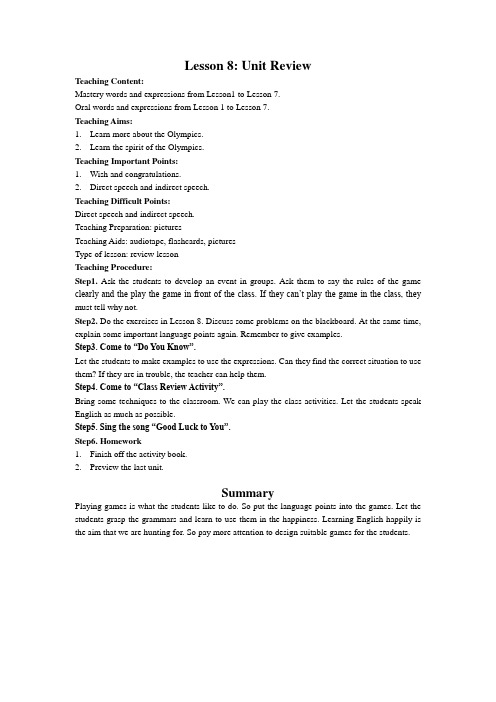
Lesson 8: Unit ReviewTeaching Content:Mastery words and expressions from Lesson1 to Lesson 7.Oral words and expressions from Lesson 1 to Lesson 7.Teaching Aims:1.Learn more about the Olympics.2.Learn the spirit of the Olympics.Teaching Important Points:1.Wish and congratulations.2.Direct speech and indirect speech.Teaching Difficult Points:Direct speech and indirect speech.Teaching Preparation: picturesTeaching Aids: audiotape, flashcards, picturesType of lesson: review lessonTeaching Procedure:Step1. Ask the students to develop an event in groups. Ask them to say the rules of the game clearly and the play the game in front of the class. If they can’t play the game in the class, they must tell why not.Step2. Do the exercises in Lesson 8. Discuss some problems on the blackboard. At the same time, explain some important language points again. Remember to give examples.Step3. Come to “Do You Know”.Let the students to make examples to use the expressions. Can they find the correct situation to use them? If they are in trouble, the teacher can help them.Step4. Come to “Class Review Activity”.Bring some techniques to the classroom. We can play the class activities. Let the students speak English as much as possible.Step5. Sing the song “Good Luck to You”.Step6. Homework1.Finish off the activity book.2.Preview the last unit.SummaryPlaying games is what the students like to do. So put the language points into the games. Let the students grasp the grammars and learn to use them in the happiness. Learning English happily is the aim that we are hunting for. So pay more attention to design suitable games for the students.。
1A Unit8 一年级上册第八单元教案
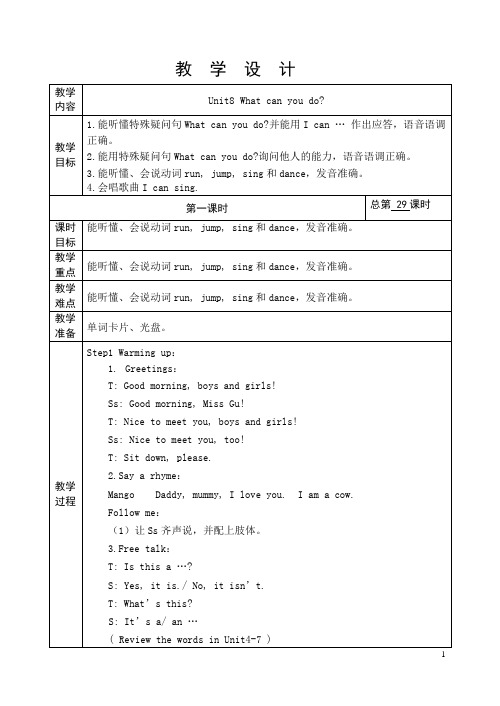
T: OK! Jump!(边说边做,repeat 3 times)
T: Now, let’s do it together!(边说边做)
3.Play a game: Listen and do
T: Jump.
Ss边说边做
T: Run.
T: What’s this?
S: It’s a/ an…
(Review the words in Unit4-7)
(由师生问答,再生生问答)
Step2 Revision:
1.Say a rhyme:
Follow me.
(1)让Ss齐声说,边说边做。
(2)点名让S上台表演,边说边做。
2.T: Follow me.跟我做。
Step3 Consolidation:
1.Say and do:
T请四名学生到讲台前来,并给每个学生指定一个动作,让Ss做出动作,请下面的Ss依照看到的顺序说出单词。
2.Read after T
Step4 Homework:
跟录音熟读单词,家长签名。
板书设计
Unit8 What can you do?
S: I can…(复习unit8的单词)
(由师生问答,再生生问答)
Step2 Revision:
Say a rhyme
Jump, jump, jump. I can jump.
Run, run, run. I can run.
Sing, sing, sing. I can sing.
Dance, dance, dance. I can dance.
S: I can…(复习unit8的单词)
牛津小学英语1A Unit 8 What can you do 复习与拓展部分公开课教案

1A Unit 8 What can you do? 复习与拓展1. Background information:The students have learnt the words ‘run, jump, sing, dance’ and the sentences ‘What can you do? I can …’ But there are still some words and sentences we often talk about in our daily life. So I will help the kids review the contents they have learnt and share a story with them to stimulate their interest of learning and using English.2. Teaching contents:(1) New vocabulary:①Three-skill words: swim, fly, write, but(2) Key structures:①I c an’t…②I can …, but I can’t …3. Teaching aims:By the end of the lesson, the students should be able to:(1)get to know the meaning of ‘swim, fly, write’both in spoken and written forms, and pronouncethem clearly;(2)guess the meaning of the word ‘but’ from the context;(3)use structures like ‘I can …, but I can’t …’ to talk about competence;(4)understand the meaning of the story ‘A Supergirl’ and act with the help of pictures;(5)get to be helpful.4. Focus of the lesson:(1) understand the new words and the sentences;(2) role play the story with the right pronunciation, facial expressions and body language.5. Predicted area of difficulty:(1) the pronunciation of ‘swi m, wr i te’;(2) the usage of some expressions about competence, such as ‘I can …, but I can’t …’6. Teaching aids:pictures, cards, CAI7. Teaching procedures:Step 1 Warm up & Free talk(1) Enjoy a song: What can you do?(2) Sing a song: I can sing.(Sing about ‘sing, dance, run, jump’ with the music of ‘I can sing’)(3) I can say: Get Ss to say ‘I can …’ in ten seconds to see who is super.(4) I can guess: Get Ss to guess what the teacher can do according to the hints.Ss: Miss Zhang, Miss Zhang, what can you do?T: I can …( Get Ss to guess according to the picture hints. The last action is the new wo rd ‘write’.) Step 2 Revision & Presentation(1) Show ‘h i, M i ke, l i ke’ and lead Ss to read the new word ‘wr i te’. Then chant.Write, write, write.I can write.Write, write, write.Write like Mike.(2) T: I can sing, I can run, I can dance, I can write. I’m a super teacher. I have a super friend. (Show apicture of Supergirl) Let’s go and find her.I can climb: Look at the pictures, words and sentences, then read them.(3) T: Look, Supergirl is coming. She can fly.Learn to say the word ‘fly ’ with the words ‘my, bye ’. Then chant.Fly, fly, fly.I ___ ____.Fly, fly, fly.____ like ____.(4) T: Supergirl can fly. Wow, she is really super. What else can she do?Get Ss to listen and learn to say the word ‘swim ’ with the words including the letter ‘i’ pronounced[I].Then chant.(5) I can play: If they see a word or a picture, then read it. If they see a super sign, then say ‘super ’.(6) I can chant: Say the super chant together.(7) Watch the story and find out the answer.T: But can Supergirl do everything? (Learn to say the new word ‘but ’ by the help of ‘mum, run ’)(8) Learn the new structure ‘I can ’t …’ and read ‘I can ’t write ’. Lead Ss to say what they can ’t do.(9) Show the pictures of the story and lead out the word ‘but ’. Then show a learning tip about the usageof ‘but ’.(10) I can find: Get Ss to say the sentence ‘I can …, but I can ’t …’ and find who can help them.Step 3 Consolidation(1) I can read: Get Ss to imitate after the computer.(2) I can act: Get Ss to practise in pairs and then try to act.Step 4 Production1. Supergirl is super and helpful. She can help others. Let ’s go and see.eg. Duck: Quack, quack. I can swim, but I can ’t fly. (配动作和声音)Get Ss to help the animals speak out their problem and get the help from Supergirl.2. T: Do you want to help others with Supergirl? Show yourself.Get Ss to show themselves and do self-introduction in different levels.Step 5 Homework1. 表演故事A Supergirl 。
小学一年级英语 1AUnit8OxfordEnglishBook1AUnit8第三教时
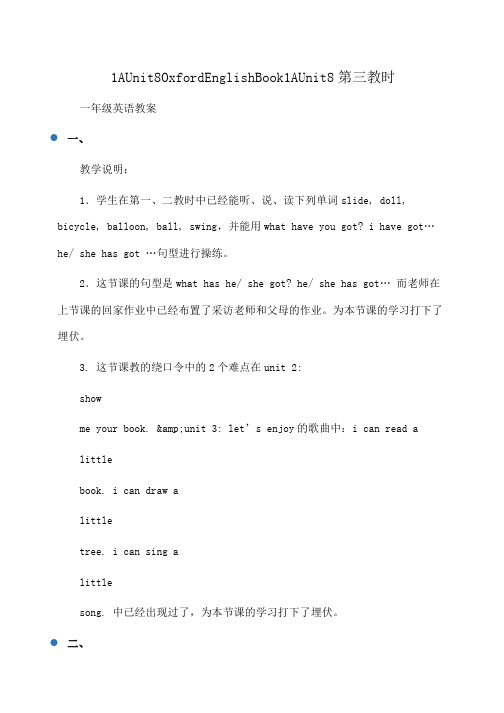
1AUnit8OxfordEnglishBook1AUnit8第三教时一年级英语教案●一、教学说明:1.学生在第一、二教时中已经能听、说、读下列单词slide, doll, bicycle, balloon, ball, swing,并能用what have you got? i have got… he/ she has got …句型进行操练。
2.这节课的句型是what has he/ she got? he/ she has got… 而老师在上节课的回家作业中已经布置了采访老师和父母的作业。
为本节课的学习打下了埋伏。
3. 这节课教的绕口令中的2个难点在unit 2:showme your book. &unit 3: let’s enjoy的歌曲中:i can read alittlebook. i can draw alittletree. i can sing alittlesong. 中已经出现过了,为本节课的学习打下了埋伏。
●二、教学内容:1) 认知内容:a. 能听懂会说并会用句型:what ha s he /she got? he / she has got…b. 能听懂会说绕口令:the boy shows the ball to the doll. the little boy shows the little ball to the little doll.2) 能力要求:在学习和生活中能询问对方:他人拥有什么,并回答,并能表达他人拥有什么。
3) 情感态度:通过绕口令的学习,培养学生的语音语调及激发英语学习的兴趣。
三、教学过程:procedurescontentsmethodspurposepre-task preparationwarmer1. enjoy the song. p16配以动作的歌曲,既让学生进入了英语学习的氛围,又埋下了铺垫。
2. quick response.eg. show me your book. show four. etc.t→s s→s通过快速反应这个环节,能进一步激发学生英语学习的兴趣,同时既巩固了旧知,又为引出新知作铺垫while-task proceduretongue twister.1. quick response:show a ball to me. show the ball to the doll. to elicit the sentence: the boy shows the ball to the doll. the little boy shows the little ball to the little doll.2. encourage the pupils to say the sentences.the boy shows the ball to the doll. the little boy shows the little ball to the little doll.3. listen and read after the tape.4. say the tongue twister together while doing the actions..从quick response用旧句型引出新句型,难度不大,学生很容易上口。
(牛津版)一年级英语教案unit1AUnit8Whatcanyoudo
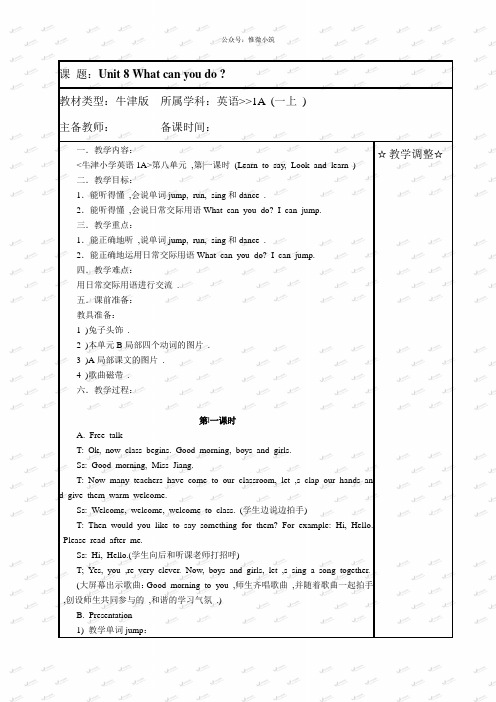
课题:Unit 8 What can you do ?教材类型:牛津版所属学科:英语>>1A (一上)主备教师:备课时间:一.教学内容:☆教学调整☆<牛津小学英语1A>第八单元,第|一课时(Learn to say, Look and learn )二.教学目标:1.能听得懂,会说单词jump, run, sing和dance .2.能听得懂,会说日常交际用语What can you do? I can jump.三.教学重点:1.能正确地听,说单词jump, run, sing和dance .2.能正确地运用日常交际用语What can you do? I can jump.四.教学难点:用日常交际用语进行交流 .五.课前准备:教具准备:1 )兔子头饰.2 )本单元B局部四个动词的图片.3 )A局部课文的图片.4 )歌曲磁带.六.教学过程:第|一课时A. Free talkT: Ok, now class begins. Good morning, boys and girls.Ss: Good morning, Miss Jiang.T: Now many teachers have come to our classroom, let ,s clap our hands and give them warm welcome.Ss: Welcome, welcome, welcome to class. (学生边说边拍手)T: Then would you like to say something for them? For example: Hi, Hello.Please read after me.Ss: Hi, Hello.(学生向后和听课老师打招呼)T; Yes, you ,re very clever. Now, boys and girls, let ,s sing a song together.(大屏幕出示歌曲:Good morning to you ,师生齐唱歌曲,并随着歌曲一起拍手,创设师生共同参与的,和谐的学习气氛.)B. Presentation1) 教学单词jump:(出示兔子头饰,以兔子与学生的对话引入新课. )T: Hi, I ,m a rabbit, I have long ears and big eyes. I can jump, jump jump, I can jump.(师戴头饰表演,边说边做动作.)T: (贴jump图片) Ok, please look at here and read after me. Jump, jump.Ss: jump, jump.(生边说边做动作)T: This group read one by one. Please read and do.Ss: (开火车读单词)T: Ok, Please look at here, Who ,s he? He ,s Mike. Now please listen caref ully.(屏幕出示Mike边跳边说: I can jump, I can jump.)T: Mike can jump, Can you jump?Ss: Yes, I can jump.(开火车读I can jump)2) 教学单词run:T: Sorry, I ,m tired, I can ,t jump, but I can run. Run run, I can run. (师边说边做动作)T: (贴run图片) Ok, please look at here and read after me. Run, run..Ss: run, run. (生边说边做动作)T: I can run. Can you run? Please read it and do one by one.Ss: I can run. (开火车读I can run)3) 教学单词sing:T: Boys and girls, today you ,re very wonderful. Now SuHai and Helen are singing a song for you.Please listen carefully. (大屏幕出示歌曲I can sing ) T: Ok , sing a song, sing. (师边说边做动作)T: (贴sing图片) Ok, please look at here and read after me. Sing, sing.Ss: Sing, sing. (生边说边做动作)T: I can sing. Can you sing? Please read it and do one by one.Ss: I can sing. (开火车读I can sing)4) 教学单词dance:T: Boys and girls, today I ,m very happy, I can dance, dance dance, I can d ance. (师边说边做动作)T: (贴dance图片) Ok, please look at here and read after me. Dance, dance.Ss:dance, dance. (生边说边做动作)T: I can dance. Can you dance? Please read it and do one by one.Ss: I can dance. (开火车读I can dance)C. Look and guessT: Now please look at this picture and guess.(出示画面) She ,s SuHai, she can….Who can t ry?Ss: She can dance.T: Next one, Who ,s he? Guess!Ss: Mike!T: Yes, you ,re right! He can …Ss: He can jump.T: She can…Ss: Sing!T: The last one, Who ,s he? He can …Ss: He can run!D. Let ,s chantT: Ok, now let ,s chant together. Please clap your hands.(大屏幕出示Chant: Run run, I can run. Jump jump, I can jump. Sing sing, I can sing. Dance dance, I can dance.)(男女生比赛读,齐读. )E. Play a gameT: Today, you ,re beautiful. Let ,s play a game together, when I say a word you please do it quickly and say it loudly, Ok? For example, I say jump, you s hould do and say, understand? I can see who is the fastest?(师发出指令,学生根据指令做动作.)F. Learn to sayT: Now, I can jump. What can you do? (教师引导学生答复)Ss: I can …(生开火车答复)T: SunYi come here, now let ,s ask she :what can you do?(请一个同学上来,其他同学一起问.)Ss: What can you do?S1: I can jump. (边答复边做动作)Ss: What can you do?S1: I can sing. (边答复边做动作)Ss: What can you do?S1: I can dance. (边答复边做动作)Ss: What can you do?S1: I can run. (边答复边做动作)G. presentation: DialoguesT: Let ,s work in pairs, one ask: What can you do? one answer: I can jump or run, and do it. Understand? Let ,s begin!T: Who can come here ask and answer? Who can try?(请小朋友上来进行汇||报表演)S1: Hi, I ,m …S2: Hello, I ,m …S1: What can you do?S2: I can sing. (边说边做动作) What can you do?S1: I can jump. (边说边做动作)H. Sing a songT: Today, I ,m very happy. Are you happy? Now let ,s sing a song together.(大屏幕出示歌曲:I can sing.)以各种形式演唱歌曲.I. Homework:七.板书设计:Unit 8 What can you do ?What can you do ?I can …..教学反思:第二课时☆教学调整☆一.教学目标:1.能正确地演唱出本单元的歌曲.2.能理解本单元游戏的规那么.二.教学重点:1.理解歌词,演唱歌曲.2.理解棋盘规那么,并按相应规那么下棋.三.教学难点:1.根据自己的实际情况改编歌词并能正确地演唱.四.教学过程:A. Free talk and revision1. 出示上节课展示过的玩偶,并用它与学生对话,复习上一节课所学内容.T: Hello, boys and girls. I ,m very glad to be here again.Ss: Hello, Miss Jiang.T: I can do a lot of tings, what can you do?S1 I can jump.T: Oh, good. Hi, what can you do?S2 I can dance.……2. 用调查的方式引导学生四人一组用上节课所学句型进行操练.T: Now ask and answer in groups.S1: What can you do?S2: I can run.…..B. Sing a song1. 听本单元的歌曲.! )引导学生听歌曲并了解歌曲大意.T: Now boys and girls, let ,s relax. Shall we listen to a song? Ok, let ,s e njoy.(播放歌曲)Ss: (听歌曲)2 )让学生说出歌词的意思.T: What is the song about? Can you tell us?S1: I can run. I can jump.T: Very good.2. 用儿歌形式朗读歌词.T: Now let ,s read the lyrics.Ss: Read together.T: Good! Clap your hangs and say the lyrics.Ss:(学生一边打节奏,一边说歌词)3. 以各种形式演唱歌曲.1 )全班集体演唱歌曲.2 )学生比赛唱.3 )集体唱.4.改编歌曲.1 )教师示范.T: Boys and girls, I want to sing a new song. Do you want to listen?T: Dance, dance, I can dance. Sing, sing, I can sing. Do you want to try t o make up a new song?2) 引导学生在小组内创编新歌曲.T: Now please try to make up a new song in groups.C. Play a game教师引导学生理解游戏的意思,然后学生自己进行游戏.D. Assign homework教学反思:。
《典范英语》(1a-L13)教学参考
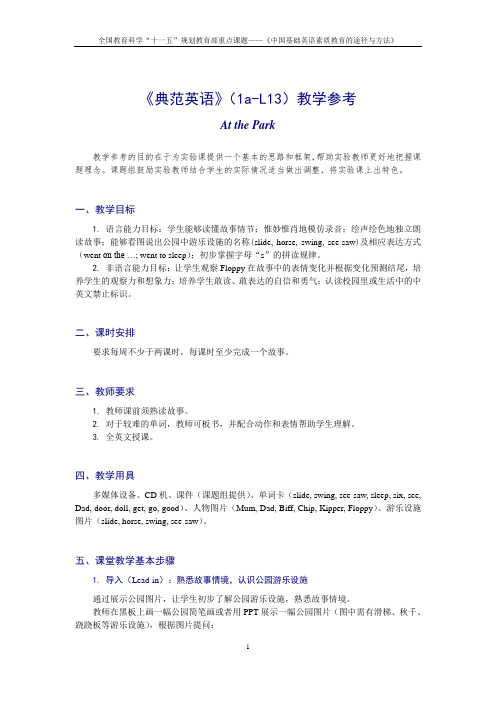
《典范英语》(1a-L13)教学参考At the Park教学参考的目的在于为实验课提供一个基本的思路和框架,帮助实验教师更好地把握课题理念。
课题组鼓励实验教师结合学生的实际情况适当做出调整,将实验课上出特色。
一、教学目标1.语言能力目标:学生能够读懂故事情节;惟妙惟肖地模仿录音;绘声绘色地独立朗读故事;能够看图说出公园中游乐设施的名称(slide, horse, swing, see-saw)及相应表达方式(went on the …; went to sleep);初步掌握字母“s”的拼读规律。
2.非语言能力目标:让学生观察Floppy在故事中的表情变化并根据变化预测结尾,培养学生的观察力和想象力;培养学生敢读、敢表达的自信和勇气;认读校园里或生活中的中英文禁止标识。
二、课时安排要求每周不少于两课时,每课时至少完成一个故事。
三、教师要求1.教师课前须熟读故事。
2.对于较难的单词,教师可板书,并配合动作和表情帮助学生理解。
3.全英文授课。
四、教学用具多媒体设备、CD机、课件(课题组提供)、单词卡(slide, swing, see-saw, sleep, six, see, Dad, door, doll, get, go, good)、人物图片(Mum, Dad, Biff, Chip, Kipper, Floppy)、游乐设施图片(slide, horse, swing, see-saw)。
五、课堂教学基本步骤1. 导入(Lead-in):熟悉故事情境,认识公园游乐设施通过展示公园图片,让学生初步了解公园游乐设施,熟悉故事情境。
教师在黑板上画一幅公园简笔画或者用PPT展示一幅公园图片(图中需有滑梯、秋千、跷跷板等游乐设施),根据图片提问:Everyone, look at the board. What’s this? (BQ: Is it a beach? Is it a park?)It’s a park.Do you often go to a park?What do you see at the park? I see …(指着画中的滑梯)Look! What’s this? It’s a slide. Do you like to play on the slide?(指着画中的秋千)Look! What’s this? (BQ: Is it a slide? Is it a swing?)It’s a swing. Do you like to play on the swing?(指着画中的跷跷板)Look! What’s this? (BQ: Is it a horse? Is it a swing?)It’s a see-saw. Do you like to play on the see-saw?之后,自然过渡到讲故事环节:Do you like the park? Biff, Chip and Kipper liked to play at the park. One day, they went to the park.2.看图讲故事(Storytelling):理解故事情节,观察一家人在公园中玩耍的情景,注意Floppy的表情变化教师利用课件逐幅播放故事图片,并用丰富的表情、生动的英文和适当的肢体语言给学生绘声绘色地讲故事,让学生观察每个家庭成员都在玩什么,充分感受一家人在公园游乐场里的欢乐。
《典范英语》(1a-L1)教学参考

《典范英语》(1a—L1)教学参考Who is it?教学参考的目的在于为实验课提供一个基本的思路和框架,帮助实验教师更好地把握课题理念.课题组鼓励实验教师结合学生的实际情况适当做出调整,将实验课上出特色。
课题组建议实验教师在教授《典范英语》(1a)前先教会学生认读和书写26个英文字母。
一、教学目标1.语言能力目标:学生能够读懂故事情节;惟妙惟肖地模仿录音;绘声绘色地独立朗读故事;能根据人物剪影辨识人物并说出人物名字;学会在不同生活场景使用“Who is it? It is …";初步掌握字母“i”的拼读规律。
2。
非语言能力目标:使学生充分体验一家人在玩影子游戏时其乐融融的家庭生活氛围;通过让学生观察人物特点和预测故事情节培养学生的观察力和想象力;培养学生敢读、敢表达的自信和勇气。
二、课时安排要求每周不少于两课时,每课时至少完成一个故事。
三、教师要求1。
教师课前须熟读故事,了解本课故事相关的文化背景:一般来说,典型的英式房子都有前院和后院,后院通常是一家人玩耍的好地方。
本故事中,这一家人就是在后院搭起帐篷做影子游戏。
2。
对于较难的单词,教师可板书,并配合动作和表情帮助学生理解。
3。
全英文授课.四、教学用具多媒体设备、CD机、课件(课题组提供)、单词卡(Mum, Dad,Biff, Chip,Kipper, Floppy)、人物图片及剪影(Mum,Dad, Biff,Chip, Kipper, Floppy)。
五、课堂教学基本步骤1。
导入(Lead—in):认识故事人物通过展示人物图片,引导学生观察人物特点,让学生认识Kipper一家人,为看图讲故事做好铺垫.(1)教师将家庭成员(Mum,Dad, Biff,Chip,Kipper,Floppy)的图片粘贴在黑板上,用This is …句型逐一介绍。
We have some new friends. They are a family。
Shall we meet them?(指着Mum人物图)This is Mum.(指着Dad人物图)This is Dad.(指着Biff人物图)This is Biff.(指着Chip人物图)This is Chip。
《典范英语》(1a-L18)教学参考

《典范英语》(1a-L18)教学参考Push!教学参考的目的在于为实验课提供一个基本的思路和框架,帮助实验教师更好地把握课题理念。
课题组鼓励实验教师结合学生的实际情况合适做出调整,将实验课上出特色。
一、教学目标1.语言能力目标:学生能够读懂故事情节;惟妙惟肖地模仿录音;绘声绘色地独立朗读故事;能够区分“push”和“pull”;掌握字母“u”的两种拼读规律。
2.非语言能力目标:通过故事培养学生遇到困难可寻求他人帮助的意识;体会故事结尾的小滑稽;培养学生敢读、敢表达的自信和勇气。
二、课时安排要求每周不少于两课时,每课时至少完成一个故事。
三、教师要求1.教师课前须熟读故事,了解本课故事内容。
2.对于较难的单词,教师可板书,并配合动作和表情帮助学生理解。
3.全英文授课。
四、教学用具多媒体设备、CD机、课件(课题组提供)、标识图片(PUSH,PULL)、故事图片、单词卡(stuck 1张、pushed 2张、pulled 2张)、拼读单词卡(push, pull, put, full, bull, stuck, Mum,butter, rug, up, trumpet, drum)。
五、课堂教学基本步骤1.导入(Lead-in):了解push和pull通过展示图片和动作演示,让学生了解push和pull,为看图讲故事做好铺垫。
(1)教师展示图片1(见课件):Everyone, look at these two signs. What do they mean?(2)教师展示图片2(见课件),通过动作演示词意:Let me show you. This is PULL andthis is PUSH.(3)教师让学生把PUSH和PULL标志贴在门上适合的位置,然后让学生一边做推门或拉门的动作,一边说:I push the door.或I pull the door.。
之后,自然过渡到讲故事环节:Today we are going to learn the storyPush!. Who wouldpush? What would he/she push? Let’s see.2.看图讲故事(Storytelling):理解故事情节,观察陷住的车最后是如何出来的教师利用课件逐幅播放故事图片,并用丰盛的表情、生动的英文和合适的肢体语言给学生绘声绘色地讲故事,让学生观察车陷住后一家人都用了什么方法,最后车是如何出来的。
《典范英语》(1a-L1)教学参考

《典范英语》(1a-L1)教学参考Who is it?教学参考的目的在于为实验课提供一个基本的思路和框架,帮助实验教师更好地把握课题理念。
课题组鼓励实验教师结合学生的实际情况适当做出调整,将实验课上出特色。
课题组建议实验教师在教授《典范英语》(1a)前先教会学生认读和书写26个英文字母。
一、教学目标1。
语言能力目标:学生能够读懂故事情节;惟妙惟肖地模仿录音;绘声绘色地独立朗读故事;能根据人物剪影辨识人物并说出人物名字;学会在不同生活场景使用“Who is it? It is …";初步掌握字母“i”的拼读规律。
2.非语言能力目标:使学生充分体验一家人在玩影子游戏时其乐融融的家庭生活氛围;通过让学生观察人物特点和预测故事情节培养学生的观察力和想象力;培养学生敢读、敢表达的自信和勇气.二、课时安排要求每周不少于两课时,每课时至少完成一个故事。
三、教师要求1。
教师课前须熟读故事,了解本课故事相关的文化背景:一般来说,典型的英式房子都有前院和后院,后院通常是一家人玩耍的好地方.本故事中,这一家人就是在后院搭起帐篷做影子游戏。
2.对于较难的单词,教师可板书,并配合动作和表情帮助学生理解。
3.全英文授课。
四、教学用具多媒体设备、CD机、课件(课题组提供)、单词卡(Mum,Dad, Biff, Chip, Kipper,Floppy)、人物图片及剪影(Mum,Dad,Biff, Chip, Kipper,Floppy)。
五、课堂教学基本步骤1。
导入(Lead—in):认识故事人物通过展示人物图片,引导学生观察人物特点,让学生认识Kipper一家人,为看图讲故事做好铺垫。
(1)教师将家庭成员(Mum, Dad, Biff,Chip, Kipper, Floppy)的图片粘贴在黑板上,用This is …句型逐一介绍。
We have some new friends。
They are a family. Shall we meet them?(指着Mum人物图)This is Mum.(指着Dad人物图)This is Dad.(指着Biff人物图)This is Biff。
2019苏教译林牛津小学英语教案1AUnit8
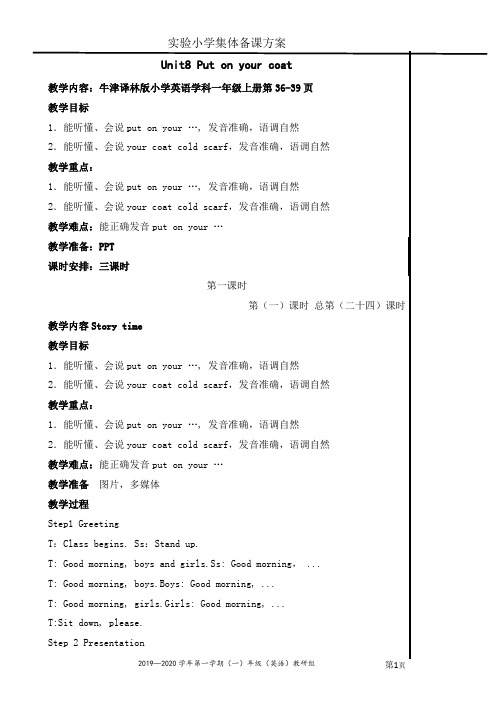
教学重点难点
教学重点:1.能听懂、会说put on your…,发音准确,语调自然
2.能听懂、会说beanie,sweater,发音准确,语调自然
教学难点:能正确发音put on your…
教学准备图片,多媒体
教学过程
Step1 Greeting
Reቤተ መጻሕፍቲ ባይዱd after the tape one sentence by one.
choose the way you like to read
Tips:
Read by yourself.
Read in roles with your partners.
Read in groups.
10.what can we say to the little match girl?
T:Class begins.
Ss:Stand up.
T: Good morning, boys and girls.Ss: Good morning,...
T: Good morning, boys.Boys: Good morning, ...
T: Good morning, girls.Girls: Good morning, ...
Unit8 Put on your coat
教学内容:牛津译林版小学英语学科一年级上册第36-39页
教学目标
1.能听懂、会说put on your…,发音准确,语调自然
2.能听懂、会说your coat cold scarf,发音准确,语调自然
教学重点:
1.能听懂、会说put on your…,发音准确,语调自然
牛津小学英语1A Unit8 What can you do教案

Unit 8 What can you do (第一课时)教学内容《牛津小学英语1A》第八单元,第一课时教学目标:1.能听懂、会说动词run jump sing dance ,发音准确2.能听懂特殊疑问句What can you do 并能用I can ...来回答,语音语调准确教学重点:1.学习单词run jump sing dance2.学习句型I can...教学难点:1.能熟练地运用句型I can ... 表达自己的想法2.sing dance run jump 的正确发音教学准备:1.单词、句型卡片,动物头饰(猫、狗、猪、牛、鸭和兔子头饰各一)2.手鼓一个(正面画一个大问号,背面贴若干糖果),将糖果吊在丝线上3.课前在黑板上画一只兔子(缺一只眼睛、一只耳朵和一个鼻子)教学过程:Step1 Warm up1.GreetingsT:Good morning, boys and girls.What’s your nameS1:I’m …T:Hello! / Good morning,….2. T:Now boys and girls, please follow me.(师发命令)Stand up/ hands up/ /hands down/ sit down./ touch your nose/ touch your mouth/ touch your eyes/ Turnaround…S:生做动作Say a rhyme:Hands up, hands down.Follow me ,and turn around.3. T:Well done. Now let’s play a game. Let’s guess. What’s this师学动物叫声:Miaow ,Miaow /Moo, Moo /Oink, Oink /Quack, Quack /Woof, WoofS:It’s a cat/ cow/ pig/ duck/ dog.Say a rhyme:I’m a cow, Moo ,Moo.I’m a duck, Quack ,Quack.I’m a cat, Miaow ,Miaow.I’m a pig, Oink ,Oink.I’m a dog, Woof, Woof.Step2 Presentation1.Teach “I can ...”师手指黑板上的兔子T:Look!Is that a cat/ cow/ pig/ duck/ dogS: No, no, no.T: It’s a rabbit. Look, one eye, one ear, one mouth, what’s missing Oh, I can draw an eye, who can draw 请学生上前将兔子的另一只耳朵和鼻子补充画完。
小学一年级英语 1AUnit8OxfordEnglishBook1AUnit8第二教时
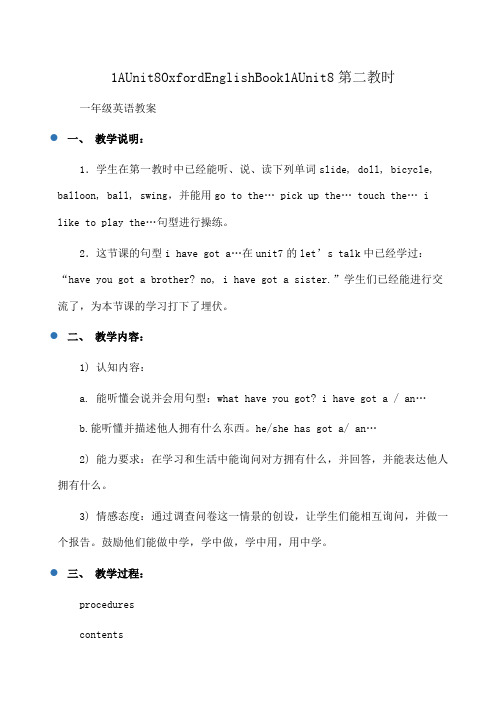
1AUnit8OxfordEnglishBook1AUnit8第二教时一年级英语教案●一、教学说明:1.学生在第一教时中已经能听、说、读下列单词slide, doll, bicycle, balloon, ball, swing,并能用go to the... pick up the... touch the (i)like to play the…句型进行操练。
2.这节课的句型i have got a…在unit7的let’s talk中已经学过:“have you got a brother? no,i have got a sister.”学生们已经能进行交流了,为本节课的学习打下了埋伏。
●二、教学内容:1) 认知内容:a. 能听懂会说并会用句型:what have you got? i have got a / an…b.能听懂并描述他人拥有什么东西。
he/she has got a/ an…2) 能力要求:在学习和生活中能询问对方拥有什么,并回答,并能表达他人拥有什么。
3) 情感态度:通过调查问卷这一情景的创设,让学生们能相互询问,并做一个报告。
鼓励他们能做中学,学中做,学中用,用中学。
●三、教学过程:procedurescontentsmethodspurposepre-task preparationwarmer1. enjoy the rhymee.g.: a slide. a slide. i like to play. a swing. a swing. i like to play. etc.配以动作的儿歌既让学生能进入英语学习的氛围,又复习了上节课所教的英语单词。
2. teacher asks the students some questions.eg. what do you like to play?p1: i like to play a ball.here’s a picture of the ball.p1: thank you.t→s通过问答这个环节,能进一步巩固英语单词,同时也为引出新知作铺垫while-task procedure1. a new pattern:what have you got?i have got …1. teacher asks the question to the students.e.g.: have you got a ball?p1: yes, i have got a ball.tell me, what have you got?to elicit the answer: i have got a ball.2. encourage the pupils to say the sentences.what have you got?i have got a balloon.(replace: bicycle ball etc..)3. ask the pupils to survey their friends what they have got.用旧句型引出新句型,难度不大,学生很容易上口。
- 1、下载文档前请自行甄别文档内容的完整性,平台不提供额外的编辑、内容补充、找答案等附加服务。
- 2、"仅部分预览"的文档,不可在线预览部分如存在完整性等问题,可反馈申请退款(可完整预览的文档不适用该条件!)。
- 3、如文档侵犯您的权益,请联系客服反馈,我们会尽快为您处理(人工客服工作时间:9:00-18:30)。
Good English
Lesson 8
教学目标: 了解get on 的意思
准备图片:
P1: T oady, we are talking about an exciting game.
That is the banana boat.
But how to play this game?
P2: At first, you need this.
Banana boat.
You come to a banana boat and get on it. Then, what’s next step?
P3. Then, a motorboat will drag the boat and you can ski on the water. And what will happen, if you ski really fast?
Let’s open the book and find out.
注意点:
1. 每张图片的讲课顺序要重复,方面孩子感知和记忆
2. 指图要准确,图片没有的信息避免表达出来,导致孩子因为无法对应而走神
3. 多进行互动问答交流
P4
The story is called, Get on
P5
Look in the picture.
We see Kipper’s family.
There are dad, mom, Chip, Biff and Kipper (挨个指图) Where were they?
They were at the beach (指图)
What were they doing on the beach?
They were playing banana boats.
Dad said to the kids, get on.
Who would get on the boat at first?
P6
Mom said, get on, Biff.
Who did she ask to get on the banana boat (指图)?She asked Biff (指图) to get on the boat.
P7
Biff got on the banana boat.
And who would get on the boat next?
P8
Mom said, get on, Chip.
Who did she ask to get on the banana boat (指图)?She asked Chip (指图) to get on the boat.
P9
Chip got on the banana boat.
And who would get on the boat next?
P10
Mom said, get on, Kipper.
Who did she ask to get on the banana boat (指图)?
She asked Kipper (指图) to get on the boat.
P11
Kipper got on the banana boat.
But Chip felt something was wrong (拇指向下表示不好).
What would happen?
P12
Oh, no, the banana boat fell over.
And who was on the boat?
No one.
Kipper, Biff and Chip were all in the water.
复习:
Okay, let’s listen to the audiobook and read the book after me. 教师播放录音,带着孩子把这几句话读一遍。
